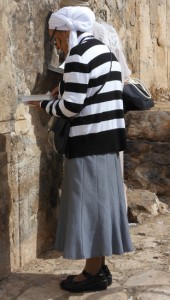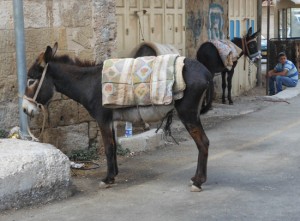×


We have detected your country as:
Please click here to go to the USA website or select another country from the dropdown list.
by: Kathy DeGagne, BFP Staff Writer
 We are traveling 20 miles south of Jerusalem to the city of Hebron along Route 60, a modern freeway that follows the ancient Path of the Patriarchs. The beautiful terraced hills of Judea are covered with abundant vineyards and olive groves—a reminder of the legendary grape cluster carried back to Joshua on the shoulders of two men, a testimony to the fruitfulness of the region.
We are traveling 20 miles south of Jerusalem to the city of Hebron along Route 60, a modern freeway that follows the ancient Path of the Patriarchs. The beautiful terraced hills of Judea are covered with abundant vineyards and olive groves—a reminder of the legendary grape cluster carried back to Joshua on the shoulders of two men, a testimony to the fruitfulness of the region.
The modern Jewish community of Kiryat Arba is located just outside of Hebron proper and its name is mentioned in the Bible as another name for Hebron. Soldiers stand at the gates and are on every street corner as we enter the ancient city, on hand to prevent bloodshed in a city whose ground has already been soaked with the blood of many Jewish martyrs through the years.
The tiny Jewish sector of Hebron comprises just 3% of the land area of the whole city with a Jewish population of 850–1,000. The other 97% is Arab and judenrein, completely inaccessible to Jews, with a population of more than 215,000 Arabs.
Jewish History Begins in Hebron
The Jewish portion of the city lies adjacent to the Cave of the Patriarchs (Ma’arat HaMachpelah). The Cave of the Patriarchs is the oldest standing Jewish building in Israel and dates from the time of the Second Temple period, marking the place where Abraham, Isaac and Jacob are buried, along with the matriarchs, Sarah, Leah and Rebekah. Its massive stone walls are strikingly similar to the Western Wall, probably because they were built by the same architect, King Herod. To add to the resemblance, along its length, Jews pause to rest their heads and hands on the ancient stones to pray.
Hebron is the first real estate in Israel purchased by Abraham. He was offered the land as a gift but instead chose to pay the premium price of four hundred shekels of silver to buy a burial place for his wife Sarah (Gen. 23: 2). Abraham must have had a suspicion that, thousands of years later, the Jewish people would be accused of occupying “stolen” territory, and so made sure their right to the land was indisputable. It is being disputed nevertheless.
“Abraham buried Sarah his wife in the cave in the field of Machpelah near Mamre (that is, Hebron) in the land of Canaan. So the field and the cave that is in it were deeded to Abraham by the sons of Heth as property for a burial place” (Gen. 23:19–20).
 We leave the Cave and amble down the long staircase to the street level, browse the wares of a few vendors, pat the donkeys waiting patiently for paying customers to take a ride, and then pass through some checkpoints, with the young soldiers on duty good-naturedly posing for pictures.
We leave the Cave and amble down the long staircase to the street level, browse the wares of a few vendors, pat the donkeys waiting patiently for paying customers to take a ride, and then pass through some checkpoints, with the young soldiers on duty good-naturedly posing for pictures.
Little do we know that a sniper is on a nearby rooftop watching every move with his riflescope trained on a target, planning to shoot his next victim. This day, a 20-year-old IDF [Israel Defense Forces] soldier named Gabriel is murdered. They never find his killer, and the Hebron Sniper is free to continue his wave of terror.
That incident and every other terrorist attack in Jewish Hebron have cemented the conviction that Hebron is targeted because its significance goes far beyond its stature as an ancient city.
Israel contends with violence every single day, but even more detrimental are the concerted efforts by most of the world to pressure Israel into surrendering her right to the very land that God promised to the patriarchs. David Ben-Gurion, Israel’s first prime minister, highlighted the importance of Hebron, saying, “Jewish history begins in Hebron.” Scripture tells us that God gave the Land to the Jewish people as an inheritance. Many Jews feel that if Hebron is relinquished, their inheritance is lost forever.
Tenacity in the Face of Terror
An article in Ynetnews published in January 2016 stated that Hebron has now become the “terror capital” in Israel, with more than a third of current terrorist attacks originating from the Arab sector of Hebron, and almost forty knifing, shooting and car-ramming attacks on Jewish civilians and soldiers occurring in the Hebron area in the last three months.
The Jewish blood of generations has soaked the ancient paving stones and the dusty ground of Hebron—many men, women and children have paid the costly price of securing a place for Jewish life there, with their lives.
On a Sabbath day in August 1929, twelve cities in Israel were the targets of gruesome European-style pogroms by the Arab population. The worst massacre happened in Hebron. Jews were attacked and murdered by their Arab neighbors—those who had lived side by side with them in peace for years—many whom the Jews considered friends. The bloody pogrom at Hebron was the diabolical triumph of the Grand Mufti in Jerusalem, Haj Amin al-Husseini. Just as Hitler planned to eliminate European Jewry, Al-Husseini intended to eliminate Jewry in Mandatory Palestine; but the Arab mastermind conceived his own holocaust plan long before Hitler ever did.
After the indiscriminate slaughter of 67 men, women and children, and the horrible torture and mutilation of many more, Hebron was forced to become judenrein by the British administration, marking the only time in 3,800 years of Jewish presence in that ancient city that Jews were not allowed to live there.
Thirty-eight years later in 1967, during the Six Day War, Hebron was liberated by Jewish forces, and Jews were allowed to return there to live and worship. In the most ancient Jewish city, where God’s promise to Abraham, Isaac and Jacob was first cemented, Jewish people were finally restored to the Land of their forefathers.
The assaults continue; yet, Hebron’s Jews also continue—to not only survive but thrive. Scripture tells us that God’s eye is on the Land from the beginning of the year to its end. It is only His sovereign protection over the people to whom He has gifted the Land, and their bred-in-the-bones tenacity and courage that have assured their enduring presence in the City of the Fathers—the city of promise.
Photo Credit: Kathy DeGagne/bridgesforpeace.com
All logos and trademarks in this site are property of their respective owner. All other materials are property of Bridges for Peace. Copyright © 2024.
Website Site Design by J-Town Internet Services Ltd. - Based in Jerusalem and Serving the World.